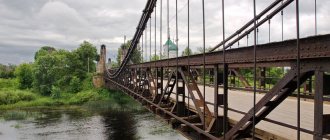Opochka: areas, recreation, excursions, museums and churches, cuisine and restaurants, shopping and shops, attractions of Opochka.
- New Year tours
to Russia - Last minute tours
to Russia
The city of Opochka, the administrative center of the Opochetsky district of the Pskov region, grew out of a fortress founded in 1414 on a bend of the Velikaya River. The fortress more than once served as a good defense against attacks by the Lithuanians and Germans, but gradually lost its defensive significance due to the expansion of the borders of the Russian state.
The name of the town is associated with the word “opoka” - “chalk limestone, white clay, alabaster.” And there is some truth to this: limestone stone from the bottom of the Velikaya River was used to lay the fortress.
Entertainment and attractions in Opochka
Opochka escaped the fate that befell many small Russian towns, and there are many historical buildings left here that survived the war and the difficult post-war period. For lovers of antiquity, the remains of the Opochetsky Wall, which once served as a city fortification, are interesting. The Church of St. John the Evangelist, the Church of the Intercession of the Mother of God, the Church of the Finding of the Head of John the Baptist, the Chapel of St. Panteleimon, the Church of St. Olga of Russia, which are located in the city and in the immediate vicinity of it, are of particular interest. In addition, Opochka is considered a convenient point for making radial excursions around the surrounding area.
Osipov-Wulf House-Museum
About 45 km separate Opochka from Trigorskoye, a place where the Osipov-Wulf House Museum (close friends of A.S. Pushkin) contains memorial items from the 17th to 19th centuries and a wonderful collection of furniture in the Empire style. Photography is prohibited inside the museum, but the magnificent park surrounding the estate provides excellent backdrops for souvenir photographs.
You can visit the attraction from 01.12 to 31.03 and from 1.05 to 14.11 from 10.00 to 17.00 every day, except Monday and the last Tuesday of each month.
Hannibal House-Museum
The Hannibal House-Museum in Petrovsky is open from 01.12 to 31.03 and from 1.05 to 14.11 from 10.00 to 17.00 daily, except Monday and the last Tuesday of each month. His address: Pskov region, Pushkinskie Gory, village. Petrovskoe. This is the estate of the great poet's ancestors. The house was recreated on the old foundation, furnished typologically, since things belonging to Pushkin’s great-grandfather were not preserved. Nevertheless, the extensive and multifaceted collection of household items presented here gives a complete picture of the life of the Russian nobility in the 17th-19th centuries.
Mikhailovskoe
First of all, places of interest in the vicinity of Opochka are those associated with the life of the great Russian poet A.S. Pushkin. About 200 km from the city is the Mikhailovskoye Museum-Estate, the family estate of the poet’s mother. More than once the estate was destroyed and restored, but the museum staff did everything possible to preserve the memory of the great poet for posterity. Unique in the quantity and value of the materials collected in it, the collection of this museum is invariably the focus of attention of tourists from different cities of Russia and abroad. Groups of children and teenagers, Pushkin scholars, people interested in Russian literature come here in the thousands every year. Not only the estate itself, but also its surroundings are worthy of inspection. The local landscapes leave no one indifferent. You can visit the museum daily from 01.12 to 31.03 and from 1.05 to 14.11 - from 9.00 to 17.00, with the exception of Mondays and the last Tuesday of each month.
Source
How to get there
The M20 highway St. Petersburg - Pskov passes through the city, the distance from St. Petersburg is 412 km, from Pskov - 137 km.
By public transport you can get to Opochka like this: train to Pskov, then by bus for about two and a half hours; There are many routes through the city, so you don’t have to worry about missing your flight. In addition, you can take a bus to the Pushkin Mountains, bypassing Pskov, and then take the Pushgory - Opochka bus, which, however, is less convenient.
Search for flights to Opochka at minimal prices
OPOCHKA
OPOCHKA, a city in Russia, in the southwest. parts of the Pskov region, center of Opochetsky district. Us. 10.3 thousand people (2017). Located on the river. Velikaya, 62 km from the railway. Art. Empty. North-east On the outskirts of O. there is a federal highway St. Petersburg - Pskov - Ostrov - Opochka - Pustoshka - Nevel - the border with Belarus.
O. was founded by the Pskovites in 1414 as a result of the transfer of the city of Kolozhe to a new location (it arose no later than the 2nd half of the 14th century; it was located 12 km south of O., on a hill at the confluence of the Kudka River and the Velikaya River), destroyed Lit. troops in 1406 during the Muscovite Lithuania. wars of 1406–1408 (fortified settlement with an area of 0.8 hectares; in its northwestern part there is a cemetery where three stone grave crosses from the 15th–16th centuries have been preserved - unique monuments of the Russian Middle Ages; two of them are now in the historical local history museum O.). In Aug. 1426 O. withstood the Lithuanian-Tat siege. troops under command. Vytautas, on September 1427 – troops of the Livonian Order. On Sept. 1441 O. destroyed by fire, rebuilt in the same year. In 1501, during the Rus.-Litov. wars of 1500–03, withstood the siege of Lithuania. troops. In the fall of 1517, during the Rus.-Litov. wars of 1512–22, large forces of Polish-Litovs. troops under command. book K.I. Ostrogsky besieged O. for 28 days, but its defenders, led by the governor V.M. Saltykov, held out, and then, with the help of Russian detachments that arrived in time. troops defeated the enemy. During the Livonian War of 1558–83, numerous troops were stationed here. Streltsy garrison, O. was a gathering place and rest for Russians. troops. Perhaps in 1580 the Polish-Litovs were taken. troops, but according to the Yam-Zapolsky Peace of 1582 it remained part of the Russian Federation. state During the Time of Troubles in 1612, the inhabitants of O., together with the Sebezh Cossacks, defeated the Polish-Litovs. troops at the Zavolochye fortress and left their garrison in it.
District city of St. Petersburg. (until 1710 Ingria) province. (1708–19), Pskov province. St. Petersburg (1719–27) and Novgorod (1727–72) provinces. Center of the Pskov province (1772–76). In 1772, Belarus passed through O. a path that provided communication with Polotsk. In 1774 the city was seriously damaged by fire. In 1776–1927, a district town in the Pskov province. (in 1777–96 Pskov governorship). In the 18th–19th centuries. O. is one of the leading trade, craft and flax producers. centers of the Pskov province. In 1849, a highway from St. Petersburg to the border with Vitebsk province passed through the city, in 1916 - a railway line. village Pskov - Polotsk (destroyed in 1941–44, not restored). In 1895 gr. P. A. Heyden founded the Opochetsky District Society of Agriculture.
In Jan. 1918 installed owl. power. After the conclusion between the RSFSR and Latv. Republic of the Riga Peace Treaty of 1920 Opochetsky district. became borderline. Regional center of the Pskov region. Leningrad region (1927–30), Leningrad region. (1930–35), Kalinin region. (1935, 1941–44), Velikoluksky district. (1935–37) Kalinin region. Center of Opochetsky district (1937–41) Kalinin region. In Vel. Otech. During the war the city was occupied by Germany. troops from 8/7/1941 to 15/7/1944, heavily destroyed, liberated by units of the Red Army during the Rezhitsa-Dvina offensive. operations. Regional center of Velikolukskaya region. (1944–1957), from 1957 Pskov region. Restored to the beginning. 1950s
Opochka. Technical school building. 1913. Since 2008 Museum of History and Local Lore. Photo by D. V. Solovyov
On an island formed by the river bed. Velikaya and a fortress moat (dug in the 15th century), a fortified settlement (Val; Upper Town) has been preserved (up to 20 m high); Excavations have revealed the remains of gates, church foundations (all from the 15th century), and a gunpowder magazine (late 17th century). The city center with rectangular blocks was built according to a regular plan developed in 1774. I. E. Starov (approved in 1778). On the right bank of the Velikaya, on the site of the burned Lower Town (posad), a rectangular Cathedral Square was organized, on which the baroque 5-domed Spaso-Preobrazhensky Cathedral was built (founded in 1780, built in 1791–92, consecrated in 1795, architect I. Parfyonov; blown up in 1937), classic 2-story public buildings (1775–76, built on in 1937; formerly the House of Soviets, now a professional school) and the city. buildings (barracks) (1775–76, the 3rd and 4th floors were built on in the 1870s), the house of the merchant A. Kh. Telepnev (1830s). Among the buildings in the classicist style is also the house of the Mogilev and Pskov governor general, Count. Z. G. Chernyshev, house of the Pskov governor (both 1775), Pokrovskaya Ts. to the mountains cemetery (1804). All R. – 2nd floor 19th century built trees houses (including merchant houses) of A. V. Korsakov, I. I. Ignatovich, N. I. Kukolkin (2nd floor with neo-Gothic windows, 1870–80s, now the Children's Art School), F. S. Selyugin (1871), etc. Also in the middle. 19 – beginning 20th centuries erected: postal station with neo-Gothic style. windows (1847–54; now a bus station), stone warehouses for flax, wood. Lutheran church in the neo-Gothic style (1871–74; the interior and roof burned down in 2011), the warehouse building of the Telepnev merchants (1891; in 1999–2006 rebuilt into the Church of the Transfiguration of the Lord); building of the zemstvo hospital in the Zavelichye district (opened in 1894; now the central district hospital, with the chapel of Martyr Panteleimon, late 19th century, restored in 2001), technical. school (1913, now the Museum of History and Local Lore). House of Culture (1955; on the site of the Assumption Church, 1891–94, architect A. A. Parland, blown up in 1934). Wooden Assumption Cemetery Chapel (1995) and the Church-Chapel of the Finding of the Head of John the Baptist (2002).
Monuments: hero pilots A. F. Romanenko and S. G. Tsarkov; V.V. Mayakovsky; marble obelisk in honor of the soldiers of the 10th Guards. division that liberated O. from it. invaders (1967). Historical and local history specialist. museum (1977).
Among the large enterprises there is a food factory (production of mayonnaise, mustard), and a bakery. Production of metal products, plastic utensils, clothing, fruit and berry juices and nectars (Stimul enterprise).
Near O., former buildings have been preserved. estates, including in the village. Petrovskoye - “Petrovskaya Manor” (a house on oak stilts was built in the 2nd half of the 18th century by the owner of the estate, Count K. G. Razumovsky; in the 1780s, His Serene Highness Prince G. A. Potemkin-Tavrichesky founded a tapestry here factory); at the Terebeni churchyard - village. c. Resurrection of Christ type “octagon on quadrangle” (1776; 5-tier iconostasis; wooden tented bell tower - 1867, architect I. Puzyrev; in the crypt - the graves of M. I. Kutuzov’s parents - I. M. and A. L. Golenishchev -Kutuzov); in the village Krulikhino – estate of the Lvov princes (mid 19th – early 20th centuries; 2-storey brick house in eclectic style, park with a pond); in the village Matyushkino - the estate of D.I. Golenishcheva-Kutuzova (sister of M.I. Kutuzov) from the village. c. St. Nicholas (1795, restored in the 1990s) and a pond.
Siege (1501)
During the war of 1501–1503 between Russian troops and the forces of the Livonian-Lithuanian coalition, another attempt was made to capture the wooden walls. The conflict was notable for the fact that Pskov and Tver warriors also acted on the side of the Moscow army. They were commanded by governors from Moscow D. A. Penko and V. V. Shuisky, as well as Prince I. I. Suzdalsky-Gorbaty from Pskov. The enemy forces were led by Master Walter von Plettenberg.
After the victory in the battle of Seritsa, the Livonians moved on, but they were stopped by the epidemic. The main group turned home, a small detachment went to Pskov. They began their campaign from Opochka, but the result was disappointing for the invaders. The Opochans once again showed intransigence, and the Livonians turned back.
A little history
In the 18th and 19th centuries, the city was one of the most important trade and craft centers in the Pskov province; Opochets fairs were famous far beyond its borders. In addition, Opochetsky district was famous for the fact that it was here that the estates of Count Yaguzhinsky, the Prosecutor General of the Senate, the Lvov princes, Count Razumovsky, the favorite of Elizabeth Petrovna, were located. The latter, by the way, eventually passed to another favorite, Potemkin-Tavrichesky.
Aristocrats and favorites not only enjoyed a calm and measured life in the provinces, but also opened factories and factories on their lands: linen weaving, carpet, sailing. And the merchants looked after the interests of their small homeland. Thus, 1910 was marked for Opochka by the appearance of motor transport: local merchants purchased a bus, which began to operate flights to Ostrov and Pustoshka.
Opochka
(Pskov region)
OKATO code:
58229501
Founded:
1414
City since:
1414 City of district subordination (Opochetsky district, Pskov region)
Center:
Opochetsky district
Telephone code (reference phone)
| 81138***** | 92-2-22 |
Deviation from Moscow time, hours:
0
Geographic latitude:
56°43′
Geographic longitude:
28°39′
Altitude above sea level, meters:
90 Sunrise and sunset times in the city of Opochka
Foundation of the city
Such a place was chosen: in the bend of the Velikaya River. A new fortification was built in October 1414 near the village of Opochki, which served as the name for the fortification. The name indicates the presence in the local depths of a large amount of rock, opoka.
The fortress was “placed” at the very edge of the river bend. A ditch was dug around it and connected to the Great. The defensive structure, standing on a hill and surrounded on all sides by water, seemed impregnable. Subsequently, this turned out to be the case. None of the nine attempts to capture her were successful. The exception was the occupation by fascist troops, when the upper part of the city was no longer there.
The entire local population with tools was sent to build: picks, shovels, axes. They built it hastily; the situation required completion of construction as soon as possible. Enemies raided frequently, every three to four years. The defensive structure, as mentioned in the chronicle: “was completed in two weeks in the fall after Pokrov.”
Map-scheme for the article “Opochka”. Military encyclopedia of Sytin (St. Petersburg, 1911-1915)
In addition to flask (limestone), wood was used for walls and towers. The fortification stretched for half a kilometer. For those times it was a powerful defensive line capable of holding back the enemy.
It was possible to get inside through two entrances: the Small and Large Gates. The fortress walls were strengthened by three towers: Zavolozhskaya, Sebezhskaya and Veleiskaya. In the most prominent place, on a hill in the center of the fortified territory, the Church of the Transfiguration of the Lord was erected.
The working people who took part in the construction lived nearby, in the suburb.
On September 17, 1774, all the structures in the upper part were destroyed by fire. People moved to the territory of the settlement, which until now has become the center.
Siege (1426)
The first serious test awaited her only in 1426. On June 29, Prince Vitovt violated the truce and declared war. His army, consisting of an international team of Poles, Tatars, Czechs and the Lithuanians themselves, approached the defense line on August 1. To strengthen the troops, the prince asked to “rent” soldiers from the Tatar khan Ulug-Muhammad.
The townspeople resorted to a trick. They pretended to leave the fortification, leaving the Great Gate open. A bridge on ropes led to it, under which the Opochkans installed sharp stakes. The enemy stood for two days, not daring to enter the gate.
Finally, at the command of Vytautas, the advanced detachment of mounted Tatars rushed across the bridge in anticipation of an easy victory. The defenders, hiding in ambush, cut the ropes. The attackers fell into the ditch, onto stakes. Coming out of hiding, the Russians put the army to flight.
Opochan cut the ropes and the attackers fall onto the stakes
The captured Tatars faced cruel reprisals, usual for those harsh times: they were skinned alive, their genitals were cut off and they were stuffed into their mouths. Mutilated bodies were displayed on the fortress walls to intimidate the survivors. The ancient Simeonovskaya chronicle testifies to this. “Vytautas saw this and was filled with shame and went away,” it says.
Execution of prisoners
Siege (1427)
In 1421, a peace trade treaty was signed between the Livonian Order and Novgorod. It discussed a peaceful resolution of disputes. In reality, everything happened differently. The warriors of the order, dressed in white robes with a red cross and sword on top, continued to wage war.
In 1427, the Livonians attacked Opochka. There are no documents left indicating an attack on him. It is known that, having failed to achieve success, the knights committed atrocities in the area. “The Germans killed six people, opochan beekeepers, killed on our land...” the chronicler said in his notes. Local villages were ravaged and burned, and a large number of civilians were killed.
Siege of Opochka in 1517
Time passed, but the endless northwestern expanses of Russian lands continued to be an eyesore for our neighbors. The next coalition at the beginning of the 16th century consisted of divisions of the Kingdom of Poland and the Grand Duchy of Lithuania. Taking advantage of the absence of the main parts of the Russian troops engaged in the defense of the southern lands, the invaders attempted to occupy the Pskov lands.
At the beginning of September 1517, a unit led by the Polish hetman Konstantin Ostrozhsky left Polotsk for Pskov. Mercenaries from all over Europe, numbering 10 thousand people, fought in its ranks. However, they were only able to reach Opochka.
On September 20, the siege began. For three weeks the enemy gathered strength after the transition. He used battering rams, and on October 6 the command was given to launch an assault.
The attackers stepped on the same rake that the Lithuanian prince Vytautas and his people fell into. Opochan, led by governor V.M. Saltykov, repeated the historical example with the bridge and cutting the ropes. The vanguard collapsed on sharp stakes, the assault was repulsed. The besieged threw stones and burning barrels down. The small garrison made heroic forays, driving away the enemy. Reinforcements arrived in time to complete the job: detachments of Moscow governors I. Lyatsky and F. Obolensky-Telepnev.
In these battles, the occupiers lost about 4 thousand people, and a large number were taken prisoner. The disgruntled Polish king Sigismund I nicknamed Opochka the “demon village.”










